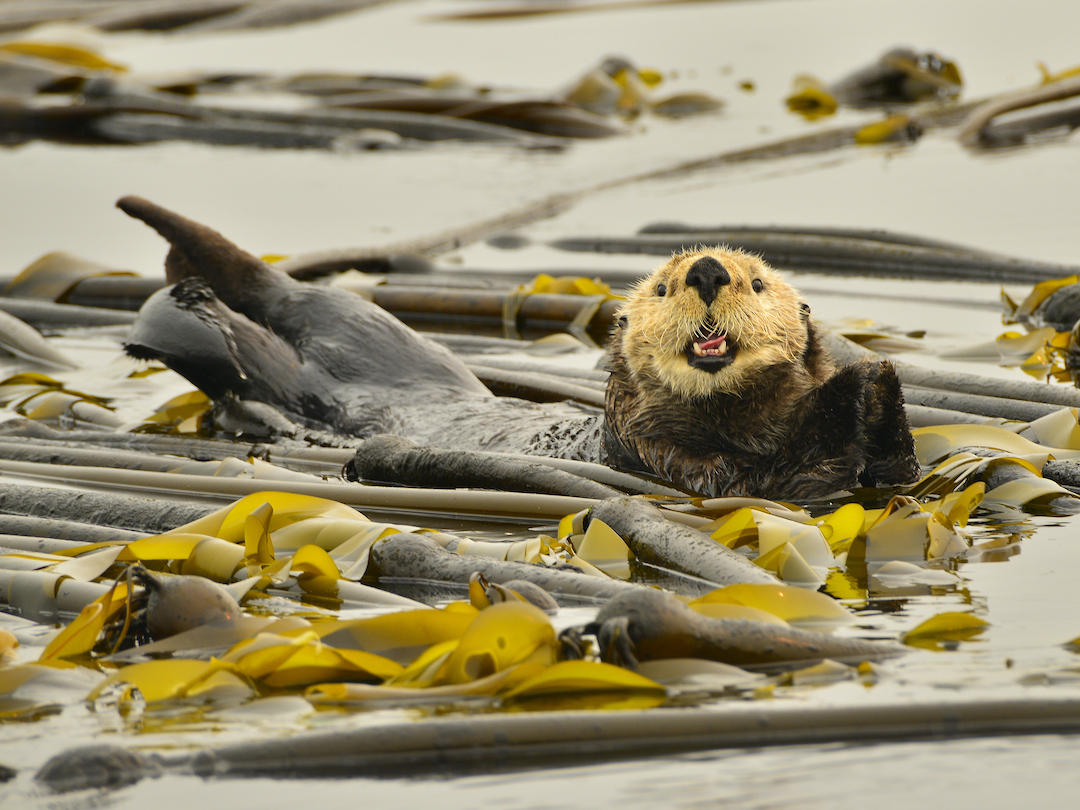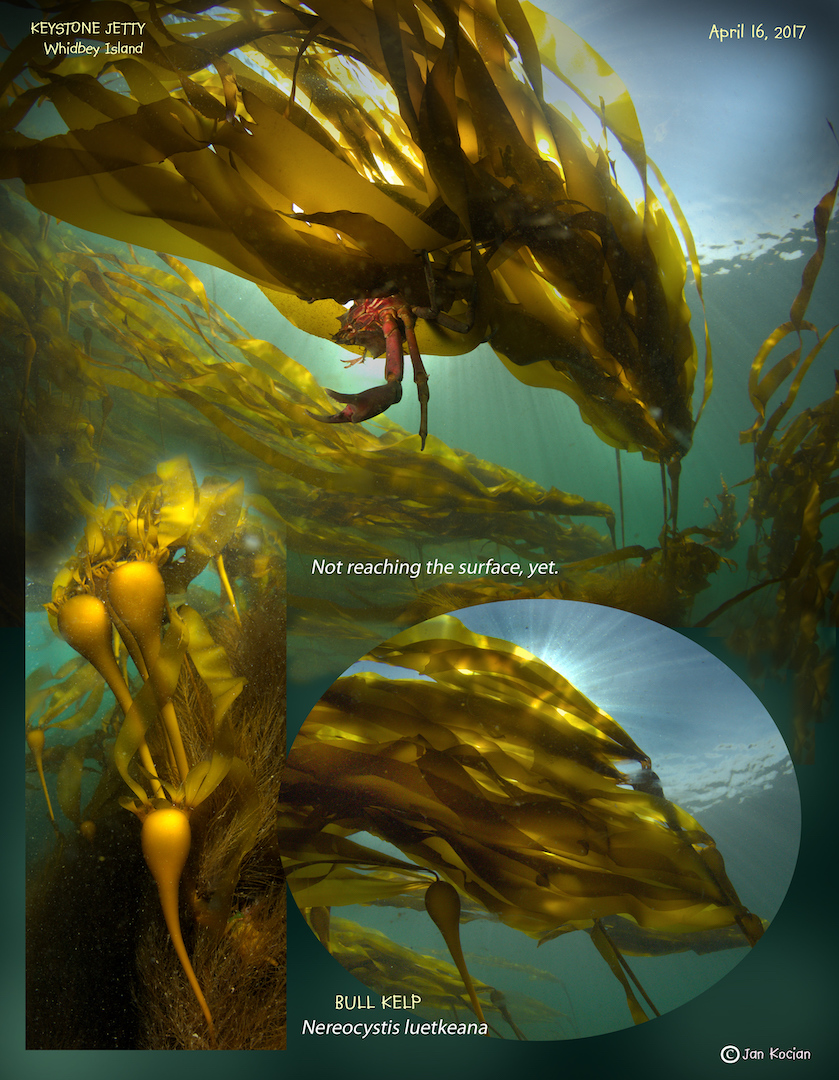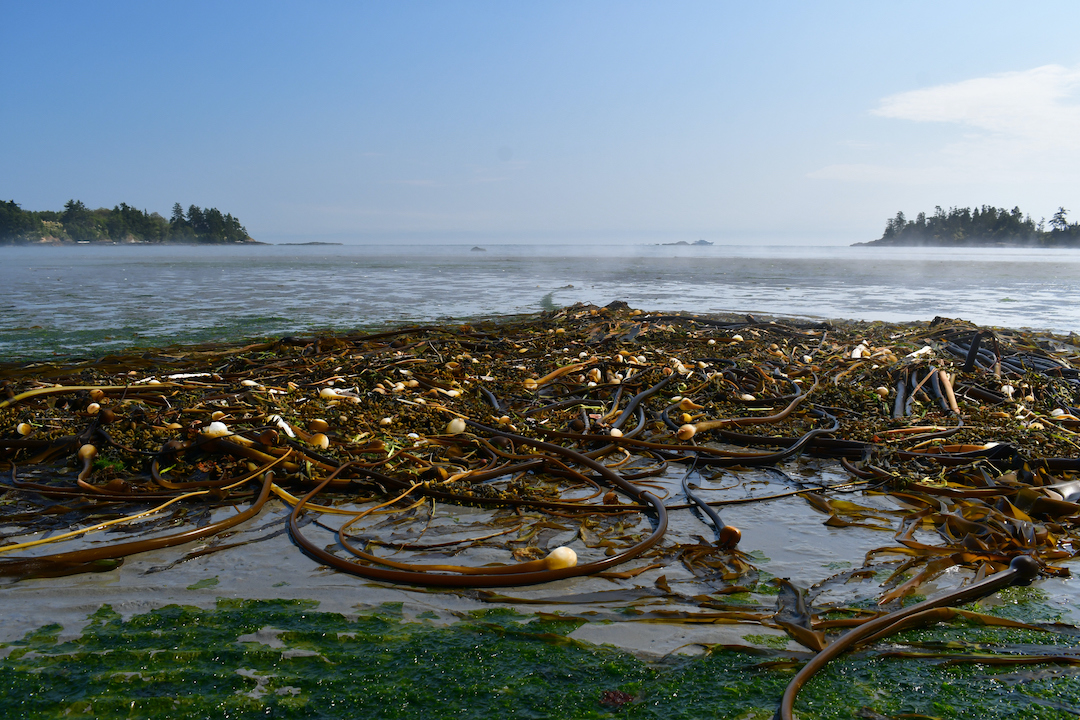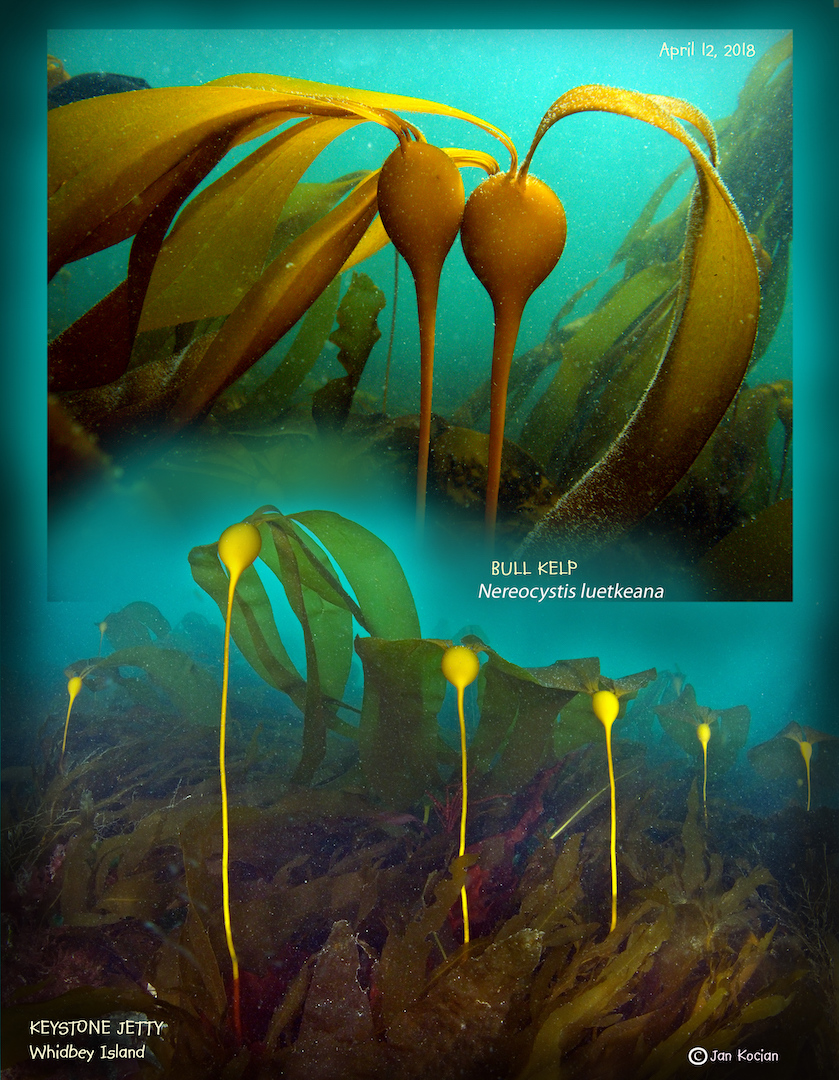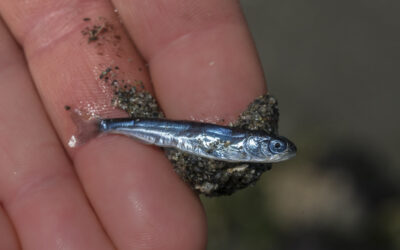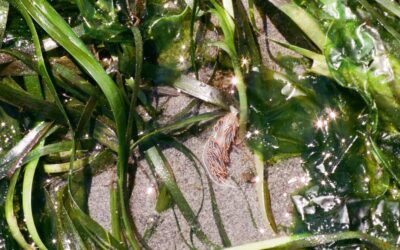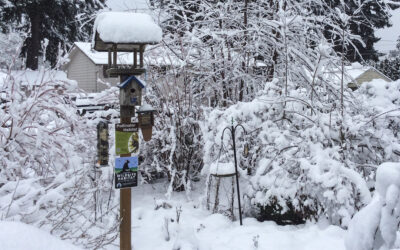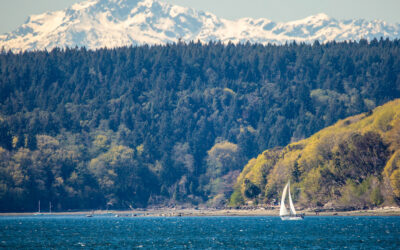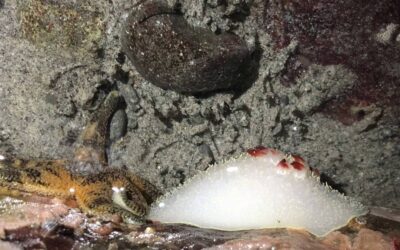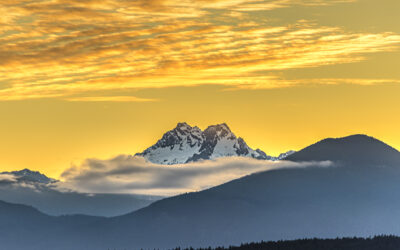KELP FOREST DECLINE AND REFORESTATION
by Marina Sannes, Winter 2022
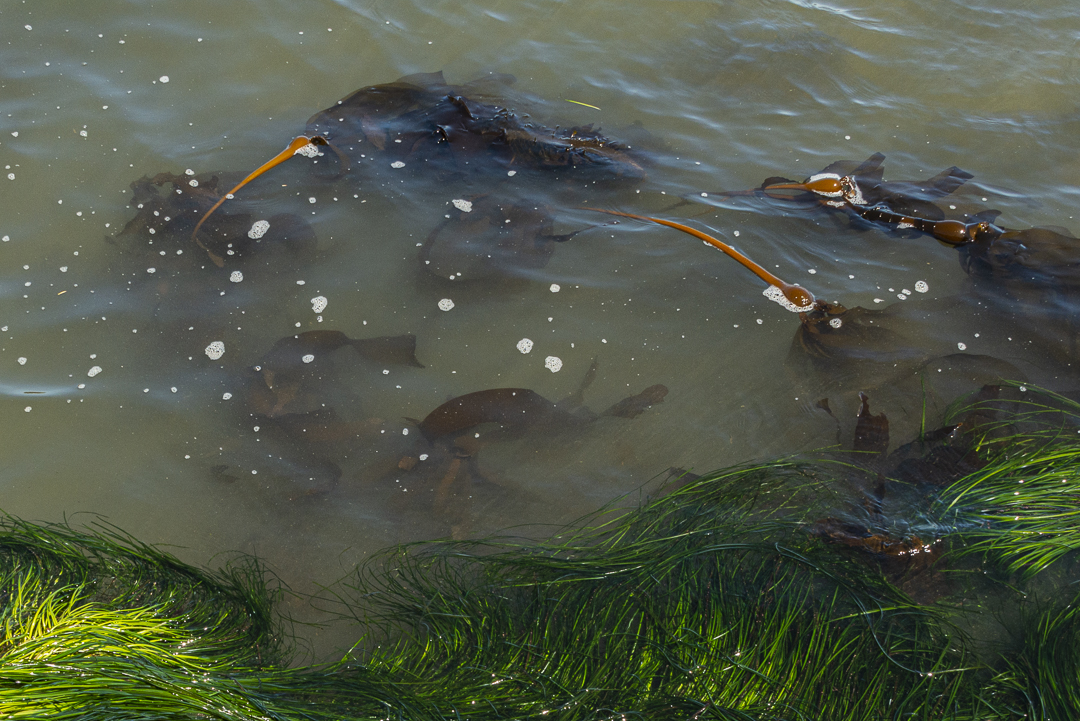
Bull kelp and eelgrass off Tongue Point in Salt Creek Recreation Area, Clallam County, WA. photo by John F. Williams
KELP FOREST DECLINE AND REFORESTATION
by Marina Sannes, Winter 2022
An iconic and beloved image, known well to those living on the West Coast and near the Salish Sea, is that of a tiny, baby otter wrapped in kelp by its mother to keep it from floating away while the mother forages. While the fuzzy otter is the main focus of the image, the kelp blanketing it is just as critical a foundation species. In the Salish Sea, the most common type of kelp is bull kelp, or Nereocystis luetkeana, reaching heights of 80 feet but typically more like 30 feet in Puget Sound. Kelp creates vast underwater forests. Bull kelp is considered a foundation species because it provides nutrients, habitat, and it is an efficient carbon dioxide absorber. These cold, dark, and wet underwater forests provide habitat, food, and resources to a variety of species, many of which are in danger. However, over the past century, there has been an unprecedented decline in these forests leading experts to worry about the impact this will have on the species which inhabit them. This is particularly true in Salish Sea.
kelp vs. rising sea temperatures
Kelp restoration efforts have been launched across the globe, though many are still in the research stages. In Australia, heatwaves had already destroyed the 100 miles of kelp along Tasmania’s coast before the Australian Government launched a restoration effort. In many cases, protecting what little of the seaweed giant that is left is far more effective than trying to completely restore decimated underwater forests that once were. At the Institute for Marine and Antarctic Studies at the University of Tasmania, researchers are exploring the possibility of warm water-tolerant kelp for future restoration.
After having tested 50 different genotypes of kelp, the researchers at the University of Tasmania noted that 10–15% are surviving in water temperatures up to 16–17°C (60-62°F), seven degrees higher than waters in which kelp normally thrives. Here in Pacific Northwest, we can take note of what has been learned Down Under.
Far from Australia, in our own Salish Sea, Brooke Weigel is working with the University of Washington’s Friday Harbor Laboratories to test bull kelp’s temperature sensitivity. In the southern Puget Sound, bull kelp continued declining at alarming rates. Over the past 145 years, bull kelp was found on 26% of the shorelines of south Puget Sound, but recently this has been diminished to merely 5% of the area’s shoreline. Record heat in recent years has not helped this dire trend. We are at a critical point, if there is to be a comeback for the bull kelp.
Bull kelp’s life cycle is intriguing and important to understand when learning why it is declining so rapidly. Bull kelp has two phases within its lifecycle (a biphasic lifecycle). The first is microscopic in size and is the ‘infant’ bull kelp (haploid gametophytes). The the second phase is an ‘adult’ bull kelp (diploid sporophyte), which reaches from the seabed to the top of the water level. Dr. Weigel conducted temperature-controlled experiments (between 10 and 22°C), to understand the effects temperature variations has on the growth of bull kelp.
As bull kelp are particularly large in size, the study was conducted with the kelp’s singular blades in temperature-controlled tanks. Beyond the lab, experiments throughout the Salish Sea itself were conducted by monitoring both water temperatures and kelp growth.
The gametophytes grown in temperatures between 10 and 16°C survived and produced adult kelp sporophytes, but kelp gametophytes from all populations died at 20°C and did not produce adult kelp sporophytes above 16–18°C.
Some parts of the Salish Sea remain relatively cool due to the Pacific Ocean water entering through the Strait of Juan de Fuca. However, areas in South Puget Sound, which are furthest from the Strait, can warm to temperatures above 16°C during the summer. Dr. Weigel’s results explain why kelp forests in southernmost South Puget Sound have been struggling far more than in other locations that are cooler.
underwater reforestation efforts
Over the past century in South Puget Sound, up to 80% of bull kelp forests have been lost, and currently restoration efforts are underway to bring the bull kelp forests back to their former glory. The importance of kelp is not to be diminished. It provides for some of our most beloved species here in the Pacific Northwest, such as salmon and orcas, as well as other organisms ranging from microscopic bacteria to other mammals. Kelp is an efficient absorber of carbon dioxide, even more efficient than trees. A study published by Dr. Filbee-Dexter and Dr. Wernberg of the University of Western Australia showed that kelp forests account for 30% of total blue carbon that is sequestered annually and 3% annual total carbon emissions globally. As kelp forests continuously grow, they are also able to attenuate storm surges whilst protecting species amongst their towering stipes and blades. The compounding benefits of kelp reforestation should put this issue at the forefront of environmental protection agendas.
Researchers, such as Dr. Weigel and her U.W. team, are providing guidance for the important task of restoring of kelp forests. While still in its initial phases, plans are in place in jurisdictions around the globe to help restore kelp forests. The Kenneth K. Chew Center for Shellfish Research and Restoration is developing techniques, such as a ‘bull kelp seed bank’ where kelp gametophytes are being gathered to cultivate and understand their genetics to create a sort of bull kelp hatchery. In 2020, the local Puget Sound Restoration Fund developed the Puget Sound Kelp Conservation and Recovery Plan to help restore kelp. The actions specifically identified in this plan include the following six goals:
- Understand and reduce kelp stressors
- Deepen understanding of the value of kelp to Puget Sound ecosystems and integrate them into management
- Describe kelp distribution and trends;
- Designate kelp protected areas
- Restore kelp forests
- Promote awareness, engagement, and action from user groups, Tribes, the public, and decision-makers
The Puget Sound Recovery plan incorporates research and management aimed at success. A collaborative effort between local government agencies, nonprofits, and local tribes is required to ensure success. Progress is slow, but thanks to these plans, continued research, and growing awareness, kelp may be given another chance to thrive in the Salish Sea and contribute to habitat restoration and carbon absorption. Hopefully these efforts will mean that bull kelp, sea otters, and other species which have seen dramatic reductions, will make good comebacks in the Pacific Northwest.
FIND OUT MORE
two videos about local kelp research
a brief video tour of a kelp forest off pender island, british columbia
other resources
Green gravel: A novel restoration tool to combat kelp forest decline, Fredriksen, S., Filbee-Dexter, K., Norderhaug, K. M., Steen, H., Bodvin, T., Coleman, M. A., Moy, F., & Wernberg, T. (2020, March 4).
Kelp Forest Restoration in Australia in Frontiers in Marine Science, Layton C, Coleman MA, Marzinelli EM, Steinberg PD, Swearer SE, Vergés A, Wernberg T and Johnson CR. (2020)
Kelp Can Help: Kelp Forests Reveal Hidden Potential for Blue Carbon Sequestration in Yale Environment Review. (2022, May 2).
Puget Sound Kelp Conservation and Recovery Plan, May 2020
Patterns of loss and persistence in kelp forests, H Berry, T Mumford, B Christiaen, P Dowty, M Calloway, L Ferrier, E Grossman, N VanArendonk (2021, March 23). ArcGIS StoryMaps.
Bull Kelp Recovery, Puget Sound Restoration Fund. (2022, August 31).
Helping The Kelp: Effects of Ocean Warming on Bull Kelp Forests, Weigel, B. (2022, October) Friday Harbor Laboratories.
2022-2026 Action Agenda, Puget Sound Partnership.
Marina Sannes grew up a ferry ride away from the Emerald City, nestled in the shadow of the Olympic Mountains, on the traditional lands of the D’Suq’Wub (Suquamish) tribe in Poulsbo. She is a high school senior at North Kitsap High School, as well as a participant in the Running Start program at Olympic College. Marina is currently applying to four-year universities and is a hopeful communications major who hopes to connect different people’s ideas and cultures with a focus on environmental issues.
Table of Contents, Issue #18, Winter 2022
Vashon Glaciation
by Adria Magrath, Winter 2022 Forage fish. photo by John F. Williamsby Adria Magrath, Winter 2022Carefully shaking wet beach sand through a series of mesh screens can be a lot of fun. On a drippy gray weekend morning near the start of winter, our small group of...
Cold, Dark, Wet Visuals
Winter 2022This opalescent nudibranch hiding amongst the swaying eel grass at Carkeek Park Beach is briefly exposed as the tide rushes out to Puget Sound. Eel grass beds hold many secrets and are often referred to as the nursery of the intertidal. Perhaps the...
Winter Characters
text and photos by Thomas Noland, Winter 2022 WINTER CHARACTERS & THEIR BEHAVIOR text and photos by Thomas NolandWhen it's cold, dark, and wet, my native plant garden provides food and shelter for many winter residents. Birds and small mammals are active, and...
Salish Sea Winter
text and photos by Michele Jaenke Winter 2022A wintery hike in Dash Point State Park. Winter snow on the Franklin Falls hiking trail. A heavy snowfall during low tide on the Puget Sound. Fall and Winter colliding in a beautiful way on a local trail. Snow brings a...
Salish Coast Cures
by Malaika Rosenfeld, Winter 2022 Nanaimo nudibranch. photo by Malaika Rosenfeldby Malaika Rosenfeld, Winter 2022the situation Swollen shades of gray horizons — wide, hanging low over dampening heads: winter in the Pacific Northwest again, and all I can think about is...
Poetry-18
Winter 2022 Looking across Hood Canal at The Brothers poking up into the sunset over the Olympics. photo by John F. WilliamsLooking across Hood Canal at The Brothers poking up into the sunset over the Olympics. photo by John F. WilliamsWinter 2022My 'Hood by Al Gunby...
PLEASE HELP SUPPORT
SALISH MAGAZINE
DONATE
Salish Magazine contains no advertising and is free. Your donation is one big way you can help us inspire people with stories about things that they can see outdoors in our Salish Sea region.
We also don't advertise Salish Magazine, so please spread the word of this online resource to your friends and colleagues.
Thanks so much for your interest and your support.
We also don't advertise Salish Magazine, so please spread the word of this online resource to your friends and colleagues.
Thanks so much for your interest and your support.

